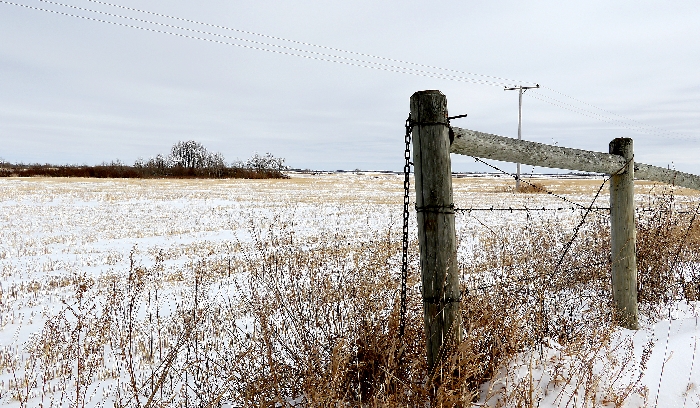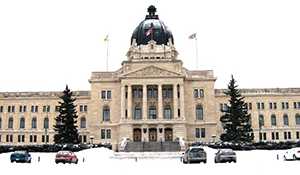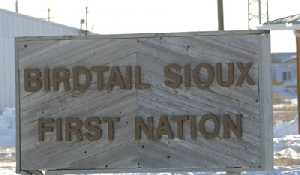April snowfall a welcome sight for producers
April 19, 2021, 1:57 pm
Spencer Kemp, Local Journalism Initiative Reporter


For many, waking up to a winter wonderland in the middle of April was not a welcome sight. But for agriculture producers in the southeast, it was like a second Christmas.
Last week much of southeastern Saskatchewan received heavy snowfall accompanied by high winds. These chilly conditions followed a week of warm and dry weather that led to fire bans in several municipalities.
Producers across southeast Saskatchewan were happy to see the snowfall which provides the soil with much-needed moisture as they begin spring seeding.
McCorriston welcomes snowfall after a dry start to spring
Mark McCorriston owns and rents farmland around Moosomin, Moosomin Lake, and Rocanville.
“I have both livestock and grainland and both of them were extremely dry. The grass was brown as brown could be and the ground was rock hard. I was really concerned about pastures and about the grass to get growing because we’ve been struggling the past few years with spring moisture, and it was quite welcome for the grass and the pastures and it’s extremely welcome for the grain aspect of it too. It was getting scary dry in the area, I was getting quite nervous about this year up until this snow,” McCorriston said.
“I was a little disappointed that it blew so hard when we got it because it is a little bit spotty and there are some deeper spots on some of the hills that don’t quite have as much, but it’s welcome and things are looking a little more promising this year.”
McCorriston says that before the timely snowfall, he was concerned about seeding.
“I had some concerns and I toyed with the idea of cutting back on my fertilizer rate because it was looking pretty scary, but things are looking like once it dries up we can get out on the field and hopefully have a good spring. Once it all melts, everything should start to grow.
“I was getting to the point where I was starting to lose some sleep over it. Nothing can grow without moisture and we had a dryer fall. We had a little bit of fall moisture but last summer it was a steady drying trend. All the low spots have dried up which is alright too, to see the slough bottoms again, but all the dirt had cracks in the ground that were an inch or two deep and the soil was rock hard. It was pretty scary.”
But with last week’s snowfall bringing much-needed moisture to McCorriston’s farmland, he says he is ready to start seeding soon.
“I’m quite content now. I wouldn’t be upset if we got a nice warm inch of rain, but if we don’t get any moisture for a week or two or even a month, I feel that it’s enough to get everything started. I would welcome more moisture, but this is what we needed to get things going. It was extremely dry.
“I would be content if we didn’t get any more but I would welcome more if we did get it.”
McCorriston explains that he hopes to start seeding this week.
“I initially planned to start seeding on April 20th if the weather remained dry and I still think we’re on board to start between April 20th and 25th and we still have a week or so for it to disappear. Because we were so dry when it does disappear we want to get on the land right away. We can already see on some high spots where the snow has melted and that dryness is coming back.”
Hruska notes delays in seeding following snowfall
Farmers across the region were impacted differently by the snowfall.
Kevin Hruska, who farms around the village of Gerald, says that while the added moisture was welcome, it is impacting his seeding process.
“Any moisture is good because we’re heading into what appears to be a fairly dry spring. For the most part with standing stubble and farming practices nowadays the snow did sit on the fields. It’s welcome moisture but it is going to delay seeding. In our case, we’re not too concerned about that because we seed fairly quick and a lot of times when we start seeding early and we want to seed our canola as well right behind it so we get done and we don’t need to stop and wait in the middle of this process,” Hruska said.
“For us, we just delay seeding for a week and we’re fine with everything as far as that goes.”
Hruska explains that while the snowfall is welcome because of the moisture it brings, post-seeding rains are more important.
“Myself personally, I didn’t feel that the snow was that big of a necessity and I thought that we had enough moisture to get the crop started. It’s that old saying of ‘if you seed in the dust your bins will bust’ and that resonates with me. Just getting a crop in place and not having a lot of trouble seeding is important. We just can’t grow a crop without some timely rains no matter what, this is only just a small factor as far as getting germination going, so I don’t really think this will carry the crop that long.”
He says that once the snow melts, seeding conditions will be nearly perfect, but more moisture will be required after seeding is complete.
“I think our seeding conditions are going to be near excellent at this point. And after seeding we’re just like any other farmers, once we’re done seeding we look to the clouds and wish for rain and wait until it comes, that’s all we can do.
“In dry years you do try to seed a little earlier but with canola, you’re limited with how early you can seed.”
Foy says a good rain is needed after seeds are planted
Kyran Foy, a Moosomin farmer with fields west of Moosomin, says that he is thankful for the snow but anticipates delays with seeding because of it.
“It’s been dry, very dry, so anytime there’s moisture it definitely helps. But at the same time, it all needs to dry up to get out into the fields. So some of it will be utilized but some of it causes delays for farmers seeding, but it was a little too early to start seeding anyways,” Foy said.
“But any kind of moisture is good when you’re dry. That’s the long and short of it.”
Prior to the snowstorm, Foy says the ground was dry but manageable for him, noting that post-seeding rain would be ideal.
“I wasn’t overly concerned myself. I dug around a bit and there was some moisture there, but we are going to need some rain after the crops are planted. Even with this snow, we’re going to need some rain.
“The snow is good but it’s not going to be near enough. The biggest thing we’re going to need is rain in May and June.”
Foy says that he hopes to start seeding this week after being delayed because of last week’s snow.
“It’s going to delay our seeding process a little bit. We were thinking of maybe starting on the 15th, which is really early for us. This just puts us back to a more normal seeding time. We’re hoping to start by April 25th. As of now, it’s not going to delay us a whole lot because I think we can still start around then as long as it dries up here a bit.”
Roberts says the moisture was needed across the region
Crops Extention Specialist with the Ministry of Agriculture Sherri Roberts says this snowfall is exactly what producers were looking for to help with seeding.
She says this extra moisture is the perfect start to the seeding season for many producers.
“Thank goodness we got some to guarantee that the soil moisture is there because there have been guys who have been out seeding just before this snow. There were some people just south of Weyburn that had seeded around 600 acres and they were finding there was some moisture in the top of the soil, the first two or three inches but then after that, it was pretty dry, so this is going to help,” Roberts said.
“Anything at this point is going to help. It sets the seeding season up for more success, and some of the winter wheat crops were looking a little rough and needed some moisture too, so this was really good and it provided them with some protection. I think everybody is happy right now, at least in the southeast.”
The dry conditions that preceded the snowfall were cause for concern for some, but Roberts says that most producers are flexible to prepared to accommodate dry conditions during seeding.
“Sometimes you need to change your seeding depths or you may need to look at putting in a different crop because certain crops can handle drier conditions and can germinate under dryer conditions better than others. So it just makes it a bit more difficult and you have to be flexible with your farming plans.
“Now I think this snow is going to provide them with good soil moisture to be seeding into, and we all know that June is the wettest month in Saskatchewan so once you get that seed in the ground and it has a bit of moisture to germinate with, you can be optimistic after that point.
“Some guys were getting worried in some areas, but with the practices that a majority of farmers in Saskatchewan have implemented there’s a lot of moisture in some of these areas but you might have to go a bit deeper. You have to watch how deep you go, though, because if you exceed the seed planting depths you can void your crop insurance. So there’s a fine line you have to walk. But I think in the southeast a majority of everybody got around four or five inches, which is going to help.”
While producers would have been able to manage with the previous dry conditions, Roberts says the snowfall a more than welcome sight.
“They were seeding with what we had, but it’s always better to have just a little bit more. The problem now is that in the areas that took a heavy dump of snow is they’re going to be delayed. It’s going to depend on how fast we warm up and some of this stuff runs off. It’s really a blessing for the dugouts for spray quality and stuff like that too. All in all, I think it’s fantastic. Everyone would have progressed onwards and done their seeding without it, but this really takes a lot of stress off the shoulders of farmers since we got this snow.”

 Tweet
Tweet



































